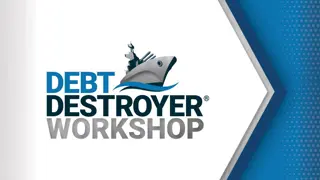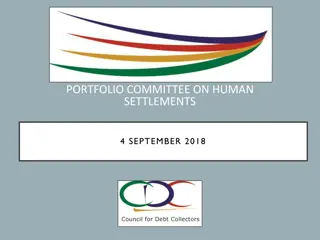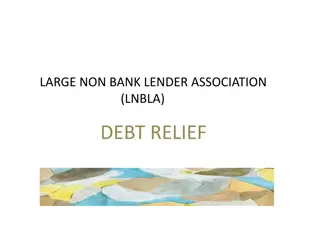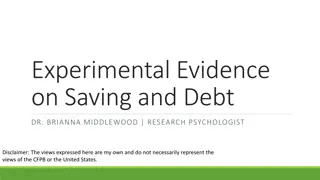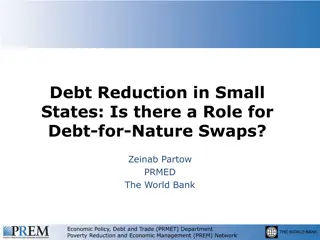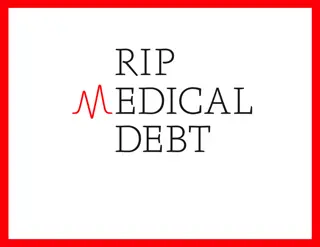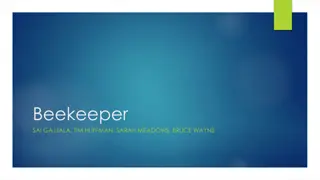Zambia's Debt Restructuring Under G20 Common Framework
Zambia is undergoing debt restructuring to address its high debt burden, with efforts including moratorium on debt service payments, involvement in the G20 Common Framework, and significant maturity extensions on existing debt. The country aims to improve its debt carrying capacity and unlock resources for developmental programs through these measures.
Download Presentation

Please find below an Image/Link to download the presentation.
The content on the website is provided AS IS for your information and personal use only. It may not be sold, licensed, or shared on other websites without obtaining consent from the author. Download presentation by click this link. If you encounter any issues during the download, it is possible that the publisher has removed the file from their server.
E N D
Presentation Transcript
Zambias Position Presenter: Mr. Peter N Mumba 1
Debt Management in Zambia Moratorium Moratorium (suspension) (suspension) on on debt debt service service payments payments from 2020 pending comprehensive debt restructuring. International International Monetary Monetary Fund Fund Program Program: : 36 months and at a value of US$1.4 billion Debt Debt Restructuring Restructuring: : Zambia hopes to restructure US$12.8 billion in order to improve its debt carrying capacity. Public Public Debt Debt Management Management Act Act Promote Responsible Borrowing Medium Term Debt Strategy Annual Borrowing Plan Debt Management Office Sinking Fund More transparency (Quarterly engagements with MoF, BoZ, GRZ) Enhanced Accountability and transparency Oversight
Debt Restructuring Under the G20 Common Framework Managed to restructure US$ 6.3 Billion of Official Creditor (0CC) Debt. A Memorandum of understanding between OCC and Creditors was finalized with China and India signing in March this year. Managed to restructure in principle our US$ 3 billion Eurobond debt. What remains is to restructure the remaining US$ 3 billion Private creditor debt.
Movements in Public Debt
Type of Debt Amount (US$ Millions) Zambia s Current Debt Position Total Public Sector Debt 25,033.34 Central Government External Debt 14,572.92 According to the Ministry of Finance and National Planning, Zambia s total debt burden increased from US$19.8 billion in 2020 reaching US$22.7 billion at the end of 2021 and US$25 billion at end of 2023 as shown in the table Guaranteed State-Owned Enterprises external Debt 1,407.14 Non-Guaranteed External Debt Fully Re-paid Central Government Domestic Debt 9,053.28 Private Sector External Debt 8,023.60 Total External Arrears 6,379.87 Total Domestic Arrears 3,704.43
Debt Restructuring Under the G20 Common Framework Significant maturity extensions of our existing debt by more than twelve years with final maturity in the year 2043. Principle repayments are starting in 2026, three years from now, however, only for 0.5 per cent of the debt stock per annum for the period 2026 to 2035 Zambia was supposed to pay US period. With agreement over the next ten years, US$ 750 million will be paid while without the agreement, we would have had to pay a US$6.3 billion. It generates US US$ $5 5. .8 8 billion billion in debt services saving which unlock resources that can be utilized for our developmental programmes. US$ $6 6. .3 3 billion billion over the
Debt Restructuring Under the G20 Common Framework Some Some risks Resumption of debt servicing (E.g US$75 million down payment on the date of exchange of bonds; US$187 million in June 2024 & US$79 million in December 2024). El Nino This has created a financing gap of about US$ 900 million. Hence, the budget needs revision & It has also contributed to a 700-mega watt power deficit in the country. (Risks around copper production, SME s and Food security). Depreciating Kwacha & Inflation BoZ Continues to embark on a tight monetary policy stance (Under performance of Bonds and Treasury Bills Offer Risk to budget financing). Rigidities in the caused by the country s IMF programs E.g. inflexible inflation target, (subsidies & cost reflective energy tarrifs). risks include include: : reserves, austerity measure
Debt Restructuring Under the G20 Common Framework What What to to look June debt service payment Revised budget Gender responsive interventions June meeting for Eurobond Holders To vote on the restructuring proposal. Investments/ performance in the mining sector key for revenues Protection of SME s Monitoring of IMF program reforms look out out for for: :
Major take aways from the IMF Program Enhance Enhance Domestic Domestic Resource Resource Mobilisation Mobilisation Various Tax Reforms Fiscal Fiscal Consolidation Consolidation Pursues Pursues contractionary contractionary Fiscal Fiscal Policy Policy - The size of the Budget is planned to contract to 33 percent in 2025 from 37 percent in 2022. Pursues Pursues contractionary contractionary monetary monetary policy policy - The IMF Programme obsesses with price stability by keeping inflation between 6-8%. Push Push towards towards cost cost reflective reflective energy energy tariffs tariffs - Tariffs to rise by an average of 17 percent between 2020 and 2025 (E.g Fuel Pump prices). Enhanced Enhanced Social Social Sector Sector Spending Spending Restoring Restoring Debt Debt Sustainability Sustainability
Advocacy for Transparency and Accountability PUBLIC INTEREST (Public Debt Management Act, the Public Finance Management Act, the Auditor General s Report on Public Debt), Adherence to Annual Borrowing Plans (Auditing). Adherence to Medium Debt Management Strategy (No non concessional debt) Establishment of the Debt Management Office Operationalisation of the Sinking Fund Transparency on Loan Conditions and Terms (Drought financing)
Thank You! Thank You!









